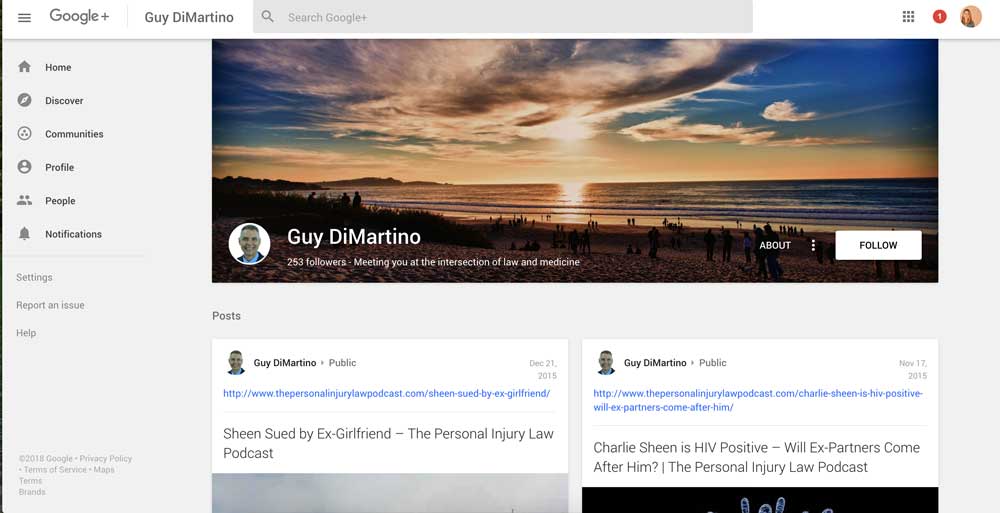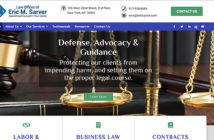Even with modest followings, his videos and podcasts are delivering high-caliber clients.
For just about any question that is likely to arise in a personal injury case, Guy DiMartino has videotaped an answer and posted it on his YouTube channel.
How to fend off bill collectors, steer a case through a bankruptcy or a divorce, or get compensated for hitting a cow, getting bedsores at a nursing home, or getting hit by a drunk driver leaving a house party—DiMartino has it covered. In the five years since he started producing videos, DiMartino, a chiropractor-turned-lawyer who splits his time between law offices in Indiana and Florida, has posted over 500 on YouTube.
Just a few have been hits. One, about the settlement value of a herniated disk, has garnered 33,000 views in four years. But most average just one view every month or two. That hasn’t discouraged DiMartino from branching out into podcasts. Over the past couple of years, he has posted over 100 episodes on two different podcasts that he has produced himself–one for medical and legal practitioners, the other for consumers.

For those who prefer the written word, DiMartino has blog posts and books—one about car accident claims, another about truck accidents, and a third about slip and falls—with different editions for consumers in each state where he practices. He gives those away free of charge as downloads on his websites, and has copies in print for those who visit his office.
Considering the time and effort he has invested in producing such a large quantity of content in multiple formats, DiMartino isn’t particularly concerned with whether very many people ever actually watch, listen to or read any of it. For prospective clients who get his name—from a Google search, or more often, by word of mouth—and look him up online, just the fact that the content is there can help “seal the deal,” he says. “I just hope that by having all of these different avenues for offering information, somebody will look at me and say, this guy knows what he is talking about. He is somebody who can be a trusted adviser and can help me.”

While the large online archive of material might help him stand out, DiMartino says client testimonials are ultimately more important. “The thing that really matters in the geographical area search is Google reviews,” he says. “That really has more of an impact than anything else because if you have more reviews that anyone else, it’s going to trigger [web searchers]to either click on your website or give you a call.” DiMartino has garnered 12 reviews, all of them five-star, for his Florida practice, and 37 reviews for the Indiana practice, all but one of which gave five stars. (The one exception, a one-star review, criticized the office for not returning a call, prompting the firm to post a response acknowledging the lapse and offering an unmitigated apology.)
The first reviews came spontaneously, says DiMartino. He has more recently started asking satisfied clients to post testimonials, particular those who told him they retained him after seeing the multiple five-star reviews.
Law as a Third Career
DiMartino worked as a chiropractor in northwest Indiana for more than a decade before he got his law degree. He kept one foot in both professions for awhile before going into law full time in 2003, initially with an established personal injury practice that did a lot of conventional advertising and needed help with litigation.
In the law practice that he continues to maintain in the same part of northwest Indiana, DiMartino & Pejic, he has partnered with an attorney who does personal injury and criminal defense. DiMartino divides his time between that office and a solo law practice in Leesburg, Florida, where he handles personal injury and prisoner rights cases. He doesn’t play up the fact, but he is also an Anglican Catholic priest.
DiMartino has never done any conventional advertising himself. “The spend is just so expensive in the personal injury market. And I just don’t have that kind of money to put out for the amount of time you need to keep doing it before you get any return,” he says.
DiMartino has an Avvo profile, but he hasn’t found listings in lawyer directories, paid or otherwise, to be useful in a field in which some firms spend “hundreds of thousands of dollars a month on TV ads.” He says, “In the personal-injury space, I think by the time somebody gets to a directory they have either gone through a bunch of lawyers or there is something off with them.”
DiMartino maintains a presence on Facebook and Twitter, but he hasn’t put much time into developing either of those platforms. “I can’t do everything. I actually have to work,” he says.

DIY Podcasts and Videos
In recent years, he has chosen to invest all of the time he can spare for marketing in producing podcasts and videos.
From the start, DiMartino, who among the other hats he wears is an Anglican Catholic priest, he wanted to produce them himself but do it right, so early on he spent a weekend with a video marketing coach in Connecticut named Steven Washer. The sessions covered the basics of lighting and sound recording, how to use editing software, and also how to present ideas compellingly in a video. DiMartino has taken it from there, and has produced his videos for the most part singlehandedly.
His foray into podcasting followed. In 2014, he launched the Chiropractic Lawyer Podcast, a collection of episodes tagged “Meeting You at the Intersection of Law & Medicine, featuring DiMartino’s interviews with lawyers and chiropractors about how they have built their personal-injury practices. He started a second series aimed at consumers, called the Personal Injury Law Podcast, which includes segments intended to be crowd-pleasing such as one about a suit that Charlie Sheen’s ex-girlfriend filed against him for exposing her to HIV.
Catchy topics of not, his podcasts never developed much of a following. He put them on hiatus for a year but plans to add new episodes soon. His expectations are low. “I don’t have a following,” he says. “I’m not that entertaining. Who really wants to listen unless they have a specific problem?” But he has found it worthwhile to continue putting out new multimedia content anyway.

Finding the Right Style
He has tried out new lighting, backdrops and choice of attire over the years, as an archive of his YouTube videos shows. But the style is much the same, and befits a priest: DiMartino, shown chest up, earnestly speaks directly into the camera.
“Everybody has a different style,” he says. “You have guys out there like the Texas Law Hawk who does these crazy, over-the-top things. That works for some people if that’s their style, but it’s not my style. I just want to answer somebody’s question, give them some basic information and show them what type of person I am. That is my style and it works for me,” DiMartino says.
“There are other folks who use iPhones to make their videos on-the-fly, but that doesn’t work for me. I don’t like having all those outside distractions and having to worry about wind or rain or ambient noises. I like to be in a controlled environment.”
Some of his videos and podcasts are scripted and he uses a prompter, he says. “Sometimes I just use an outline with two or three bullet points, and other times, they’re off-the-cuff. So it depends what I am trying to get across,” DiMartino says.
He has recently begun experimenting with Facebook Live videos. They are homespun in style, addressing topics ranging from a rare spinal cord disorder to studies about how people are affected by the color red. “My live videos are off-the-cuff. There is no script. There is just something I have read or want to talk about,” DiMartino says.

‘A Different Sort of Client’
Though he can’t vouch for the business-generating efficacy of any of his multimedia efforts, he believes the combined effect helps bring in good clients. “It’s a different approach because I’m looking for a different sort of client than those who would see traditional personal-injury lawyer advertising and would say, oh, I’m going to call that lawyer,” he says.
As DiMartino explains, “In my view the folks who come in from billboards or TV ads are in-a-wreck-get-a-check type of people. And that’s just not the way I’m set up. I want somebody who did not think about a lawyer at first–until they started to have a problem. Those are people who, one or two or three weeks out from the injury, either find out that their condition is worse than they thought, or they are getting screwed around by the insurance company, or they are starting to get overwhelmed. Then they speak to a friend or somebody else who says, give this guy DiMartino a call. And so they decide to check me out,” DiMartino says. “And then they start doing a little bit of research and going online and learning about me.”
“I think it is those people who will notice the things I have put my time into,” he says. “The other folks who want to make a quick hit after being in an accident are going to call the billboard lawyer and they will already be lawyered up.”




